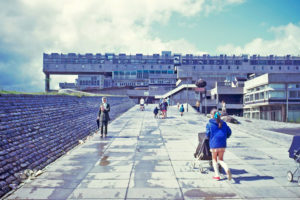There wasn’t much architecture at this year’s Venice International Architecture Biennale. The German pavilion, for instance, contains nothing more than the leftover components from last year’s Art Biennale stacked in the centre; the floorboards ripped up. The Israelis have closed their pavilion. And the Swiss have put nothing but a carpet in theirs, on which is woven a plan of the adjacent Venezuelan pavilion.
The response, as one might imagine, was mixed. On the one hand, Patrik Schumacher, principal of the major architecture practice Zaha Hadid Architects, was irate. “The Venice ‘Architecture’ Biennale is mislabelled and should stop laying claim to the title of architecture,” he wrote. Yet other critics applauded the radical change of direction. “Artists and designers have occupied these spaces in a much more convincing way than usual,” wrote Tom Wilkinson.
Exhibiting architecture is tricky: you reduce these big, expensive outdoor structures into smaller indoor ones. And how exactly? Models? Photographs? Drawings? Films? All of the above? Why would you even bother? It is an impossible but necessary game. And yet it is something that we have been playing for as long as architecture itself; so long in fact, that it is architecture.
Of course, the palazzi of the Grand Canal remain untouched, and this may seem like an esoteric, avant-garde kerfuffle that is best ignored. However, even if you are a hopeless trad, the absence of architecture at the Venice Biennale is an unsettling development, which reveals much about the predicament of today’s creative classes.
Consider the German pavilion. Not only does it lack any trace of real architecture, but its limited rhetorical force is further diluted by the fact that this has been done before. For the 1993 Art Biennale, Hans Haacke and Nam June Paik ripped up the marble floor of this kicked-about building and stuck up the words “Germania” on the back wall. Just after reunification, the artists were using the pavilion designed by Ernst Haiger, a Third Reich architect, to call into question German expansion in an admittedly unsubtle way. We got it. Today, by contrast, it isn’t immediately obvious what this round of petulant floorboard extraction is meant to symbolise. Boo Nazis again?
If so, then what explains the Israeli pavilion? And the Swiss one? Clever reasons are given for this strategy of non-representation: the Germans want to concentrate on activist community-building on the southern Venetian island of Giudecca, although whether the poor Giudeccans, who seem to have a thriving community, had any say in the matter is not disclosed. The Israelis wanted to show that their modernist pavilion is a product of a machine age. The Swiss wanted to discuss “neighbourliness”. (No one stopped to consider how you’d feel if your neighbour was displaying a plan of your house in theirs. Neighbourliness is not the word you’d use when phoning the police.)
But the emptiness endures: a questionable aesthetic strategy made all the more dubious given that the really empty pavilion is the Russian one, a symbol of their pariah status and a chilling reminder of the ongoing war in Ukraine. The commissioning cycle is long, of course, and curators can be hostage to fortune, but in comparison to this very real emptiness, the contrived desolation of other pavilions seems churlish and easy to misinterpret. Nothing can be more misunderstood than nothing.
This nothingness reflects a crisis of confidence in the creative classes, prompted by the populist moment of 2016. For once, Britain has led the way. In 2018, the British pavilion for the Biennale was empty. The curators Adam Caruso and Peter St. John made it clear that this was an articulation of what they saw as the cultural crisis prompted by Brexit: it was a kind of mute tantrum; a throwing up of the hands in the air. Far from being an isolated moment, this crisis has spread from nation to nation and for good reason.
Meanwhile, the study of architecture has become far more popular even as construction has become less likely. According to the Architects’ Council of Europe, the number of architects grew by 24% between 2008 and 2018. During that time, studying architecture became far more expensive, especially given that courses often last between five and seven years. Whatever it is we are witnessing in the pavilions of the Giardini, it has been conceived by architects who have spent more money on their education than those who exhibited in Venice over a decade ago.
The industry into which they are passing offers little reward. Although it may not seem like it, we are designing and building less. Construction output across the EU is currently running at about 80% of the levels seen before the banking collapse of 2007/8 which, in terms of housing, was just about keeping pace with demand. The net result is that the number of architects working in badly paid academic jobs has dramatically increased. Withdrawn from the act of building, architects have turned to critiquing the very idea of architecture itself. (The Czech pavilion offered a self-help guide on how to deal with the difficulties of the architecture profession, with “just leave” as one of the options.)
“Am I out of touch?” says Principal Skinner in The Simpsons. “No, it’s the children who are wrong!” he answers himself. Architects, and the architectural culture which Venice is the acme of, follow the same trajectory. The more extreme end of environmental activism — the Extinction Rebellion crowd — has found a home in the architecture profession. A sense of dislocation from the concerns of the public, and the sheer volume of materials that the architect must deploy, means that a need for increased care in allocating resources has turned into a complete abnegation of architecture. It is quite common to hear architects, whose livelihoods have historically been based on building new things, say that any new building is bad because of the climate crisis.
Yet emptiness is not the only strategy of non-representation going on throughout the Biennale pavilions. Elsewhere, there’s an odd fixation with the processes of eating and shitting. The Spanish have surveyed the food industry (not its architecture, the industry itself); the Dutch have explored plumbing and the Finnish toilets. The effect is to create an analogy between the body and the building. This mapping of construction onto consumption leaves a note of slightly scatological revulsion at our embeddedness in capitalist modes of production. (The extraordinary cartoons on the wall of the Dutch pavilion make the analogy between plumbing and banking explicit.)
Perhaps because of this, Schumacher suggests that the Venice Biennale may be conceiving its own demise. I think this is overly dramatic, and correctives to the trend towards nothingness exist. One further feature of this year’s Biennale is that firms such as GMP Architekten, one of Germany’s finest, made their own off-site pavilion (a fascinating exploration of their renovation of civic halls). Other ventures and venues are already creating a fringe, outside the official event. Furthermore, by dint of the fact that pavilions are commissioned by different bodies and there is in fact a competition at its core, there is the chance they will once again engage with the pressing needs of society. The Biennale can become an organ for helping architectural culture out of its self-regarding impasse, freeing it from its obsession with closure and emptiness.
It is outside Venice, though, that one finds architecture’s ruthlessly applied redemption. On my way home from the city, I visited an astonishing public hospital in the dockland area of Cadix in Antwerp, built by a developer-led consortium but designed by the architects Robbrecht and Daem. The process by which the building was created was often self-confounding, the architects were often unable to speak directly to the end-user, the hospital trust, during the 10 years it took to build. However, the building they have created is exceptional, all the more humane for its moments of strange compromise; the architects bloodied but unbowed after a decade of delivery. It is, in other words, considerably better than nothing.
Disclaimer
Some of the posts we share are controversial and we do not necessarily agree with them in the whole extend. Sometimes we agree with the content or part of it but we do not agree with the narration or language. Nevertheless we find them somehow interesting, valuable and/or informative or we share them, because we strongly believe in freedom of speech, free press and journalism. We strongly encourage you to have a critical approach to all the content, do your own research and analysis to build your own opinion.
We would be glad to have your feedback.
Source: UnHerd Read the original article here: https://unherd.com/




